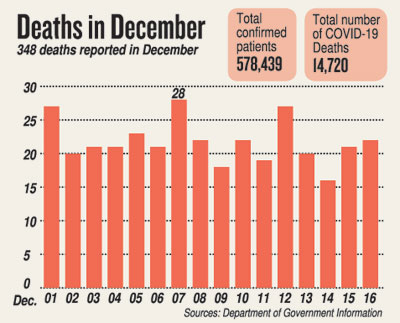News
Sifting truth from myth as concerns grow over Omicron as well as booster
The anxiety has heightened as health officials declared that four people infected by Omicron had been identified.

Dr. Rajiva de Silva
With the Sunday Times receiving many such queries, we asked Consultant Immunologist, Dr. Rajiva de Silva attached to the Medical Research Institute (MRI), Colombo, to sift the truth from myth, based on science and studies carried out across the world.
Everyone needs to take the vaccines and also the booster especially in view of Omicron doing the rounds in many countries, he stressed, pointing out that this variant has 50 mutations, 30 alone in the spike protein and 15 in the spikes’ receptor binding domain. The mutations in the receptor binding domain may make the virus more efficient in attaching itself to a human cell.
While explaining that some of the 50 mutations may be assisting the virus to evade the immune response, Dr. de Silva said that the World Health Organization (WHO) looks for four traits in new virus strains:
- Do the mutations make the variant more transmissible?
- Do the mutations make it evade immunity?
- Do the mutations make it more dangerous which can lead to severe disease?
- Do diagnostic tests ‘miss’ the mutations?
Do diagnostic tests ‘miss’ the mutations?
Focusing on Omicron, Dr. de Silva begins by answering the “easiest” – diagnostics can detect Omicron. Certain RT-PCR test kits can pick up the ‘S drop’ seen in Omicron’s mutations. So if the Alpha variant (which has the same mutation) is not around in an area, this pointer would be towards Omicron. The other kits can detect Omicron but cannot differentiate between Omicron and the other strains. Then sequencing is needed.
Do the mutations make the variant more transmissible?
With regard to transmissibility (spread), Omicron is very transmissible, he says, giving the following data:
- A month ago, there was an increase of 260 infections (maybe due to Delta) per day in South Africa. Now there is an increase of 19,000 infections a day due to Omicron
- In the United Kingdom (UK), the number of infections is doubling every 2-3 days

Seeing a “problem” in the fact that there are no peer-reviewed studies (evaluation of scientific, academic or professional work by others in the same field), Dr. de Silva says that research coming from the Hong Kong University indicates that Omicron is 70 times more transmissible than the original Wuhan virus strain. But the “good news” seems to be that the replication rate of Omicron in lung tissue (the organ mainly affected by COVID-19) is 10 times less.
Do the mutations make it evade immunity?
Describing how vaccines work, this Immunologist says that they have a two-prong approach –
- Vaccines produce antibodies – to prevent the virus from getting into cells in a human being and, in turn, prevent infection
- Vaccines produce T-cell mediated immunity – to destroy virus-infected cells in the human being
Citing real-world data put out by the insurance provider, Discovery, from South Africa, in a comparison of the first wave’s original viruses (B.1.1.54; B.1.1.56 and C.1) and Omicron across all ages (18 to 79 years), Dr. de Silva says:
- Whereas two-doses of the Pfizer vaccine gave 80% protection against symptomatic disease for the original virus, it dropped down to 33% with Omicron.
- Whereas two-doses of the Pfizer vaccine gave 93% protection against severe disease in the case of the Delta variant, there has been a drop down to 70% protection against severe disease with Omicron.
Explaining why South Africa has looked at ‘symptomatic’ disease and not ‘severe’ disease, he says that it is because what has been considered is the antibody response. In severe disease, the T-cells come into play in destroying the virus. 
He goes on to point out that there is speculation that in South Africa there seems to be an “uncoupling” (de-linking) of disease and death. Even though there is an increase in the number of infections there due to Omicron, the number of hospitalizations and death is very much less compared to Delta.
“In South Africa, even though vaccination rates are low, there have been a lot of natural infections of COVID-19 before Omicron. Therefore, such natural infections would tend to prevent people from getting severe disease, even though those infected once can get re-infected. However, if Omicron infects a population with minimal vaccination or minimal natural infection, we don’t know what would follow,” he says.
Next Dr. de Silva looks at real-world data from the UK with regard to the effectiveness of some of the vaccines not only against Delta but also Omicron:
- Two doses of AstraZeneca at 25 weeks (6.1 months) after the second dose were 41% effective against symptomatic disease caused by Delta
- Two doses of Pfizer at 25 weeks (6.1 months) after the second dose were 63% effective against symptomatic disease caused by Delta
- Two doses of AstraZeneca after 15 weeks (3 months and 3 weeks) of the second dose were zero effective against symptomatic disease caused by Omicron
- Two doses of Pfizer after 15 weeks (3 months and 3 weeks) of the second dose were 33% effective against symptomatic disease caused by Omicron Taking a very close look at the effects of boosters from data available, Dr. de Silva says:
- A Pfizer booster given either over two doses of AstraZeneca or two doses of Pfizer, takes the effectiveness against symptomatic disease caused by Delta to around 93%.
- A Pfizer booster given over two doses of AstraZeneca takes the effectiveness against symptomatic disease caused by Omicron to 70%.
- A Pfizer booster given over two doses of Pfizer takes the effectiveness against symptomatic disease caused by Omicron to 90%.
| ‘Mixing and matching’ vaccines seem best strategy There is no question that Omicron is in He says that ‘mixing and matching’ of vaccines seem to be the best strategy to beat this new variant and quotes a study of seven vaccines published in the scientific journal ‘Lancet’ in early December. These vaccines can be categorized according to the levels of neutralizing antibodies and T-cell responses from the highest to the lowest: The descending order for neutralizing antibodies –
For a T-cell response, the descending order was:
“While mRNA vaccines (Pfizer and Moderna) produce neutralizing antibodies, the adenovirus-based vaccines (AstraZeneca) are useful in the T-cell response. So Sri Lankans have got a good deal,” says Dr. de Silva, adding that as there are no data worldwide on Sinopharm “we don’t know much” about mixing and matching with this vaccine. Meanwhile, Dr. de Silva adds that studies in Chile have shown that boosting with either a Pfizer or AstraZeneca had a better effectiveness than boosting with Sinovac (an inactivated vaccine similar to Sinopharm) in people given 2 primary doses of Sinovac. This was, however, before the advent of Omicron. The WHO has recommended based on availability to administer:
| |
| Who should take what and when Here is Dr. Rajiva de Silva’s advice on vaccination:
“Once the vaccine or booster is taken, there could be minor side-effects such as fever, body aches and swelling of glands,” he says, pointing out that a study in France had shown no elevated risk of adverse events such as heart attacks, strokes or pulmonary embolisms. He adds that another study in Israel covering lakhs of people had shown that vaccination was not associated with adverse events, except rare instances of myocarditis in children who got the second dose, which are mild. Detection of Omicron cases in SL so far The highlights of the media briefing held at the Health Promotion Bureau. The Health Ministry’s Head of the Division of Disaster Preparedness and Response, Dr. Hemantha Herath said:
|
The best way to say that you found the home of your dreams is by finding it on Hitad.lk. We have listings for apartments for sale or rent in Sri Lanka, no matter what locale you're looking for! Whether you live in Colombo, Galle, Kandy, Matara, Jaffna and more - we've got them all!

